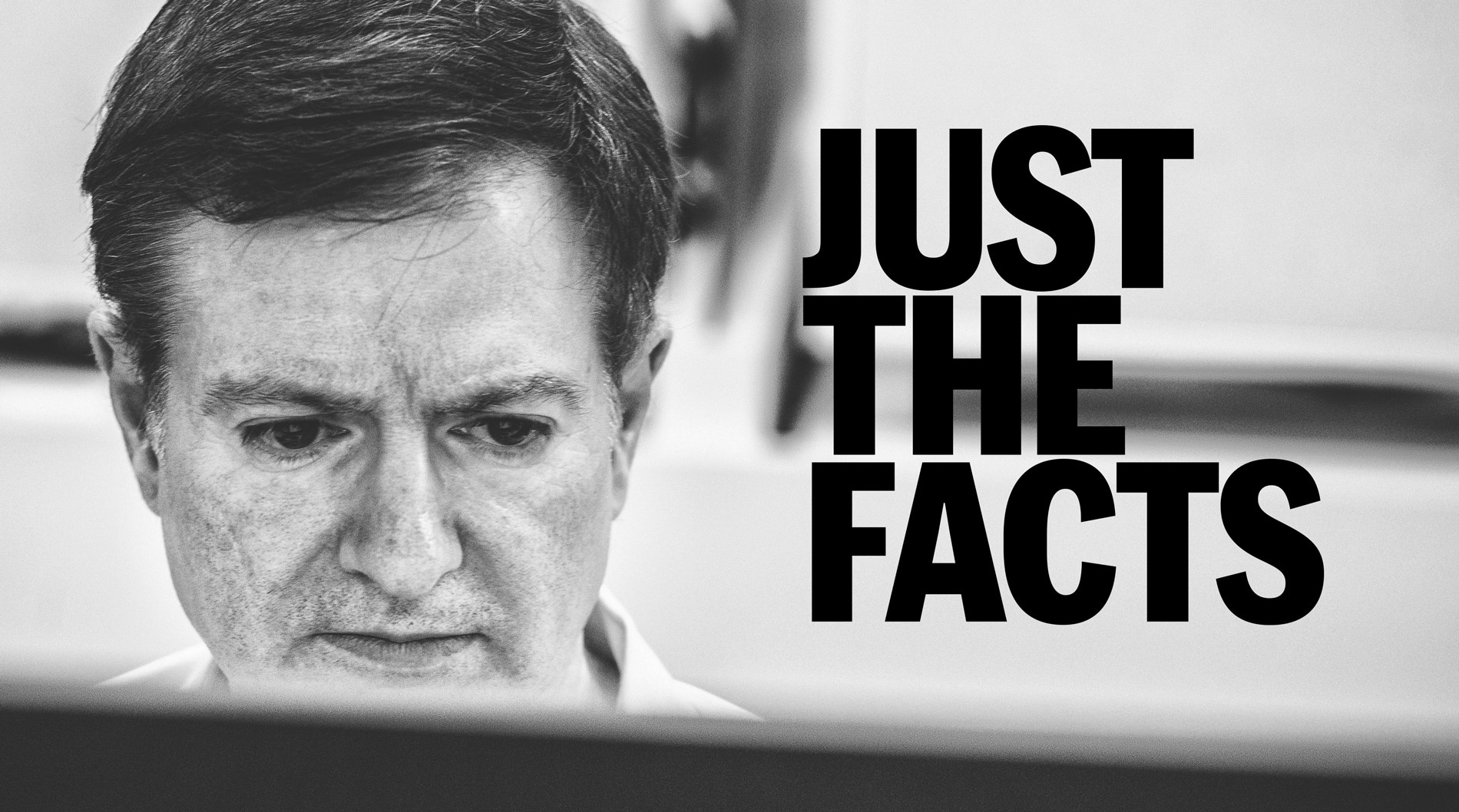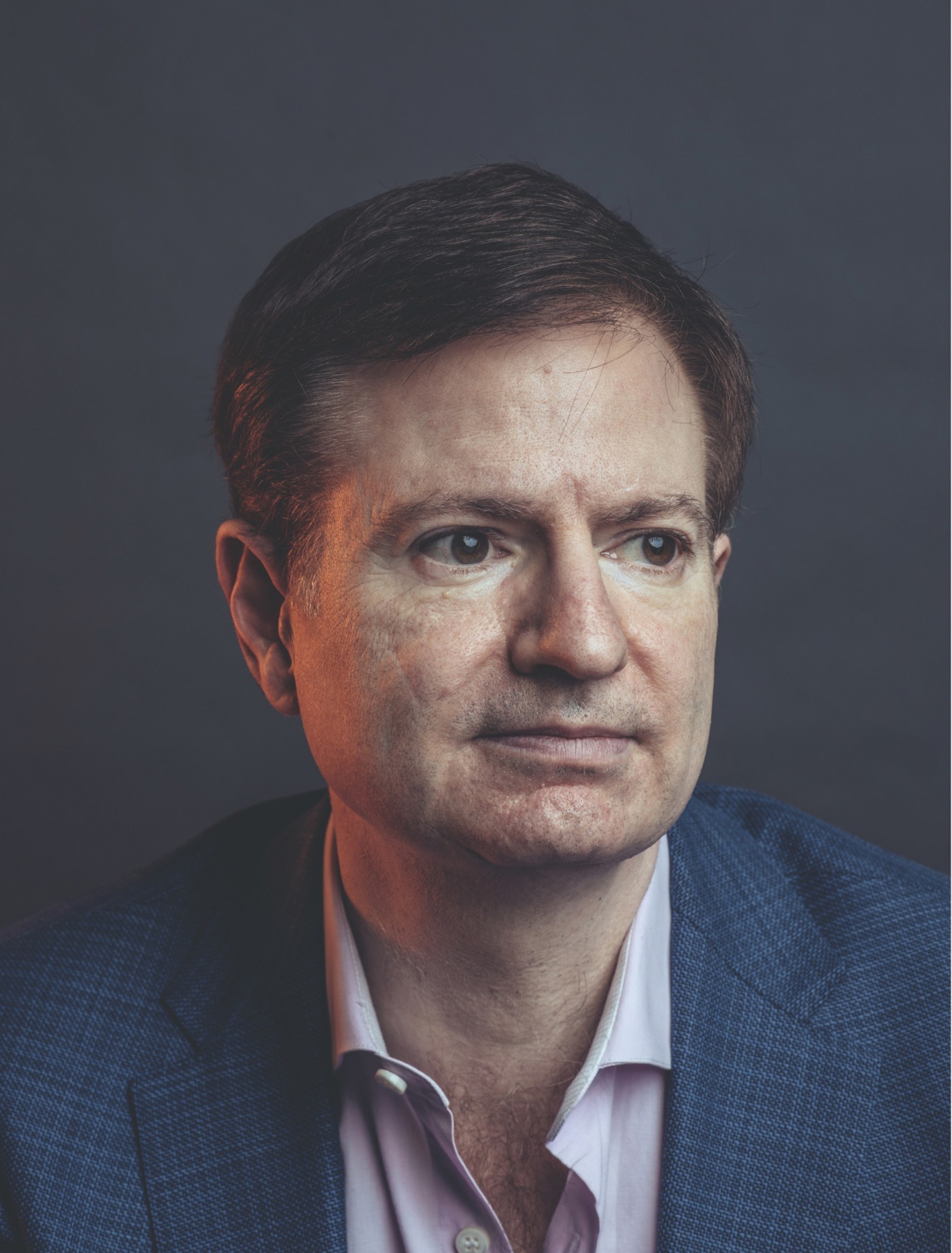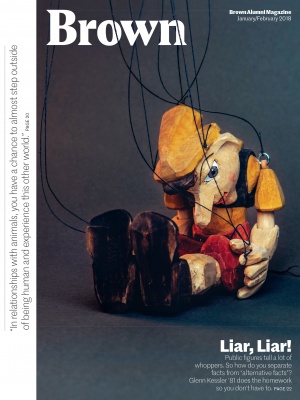
Just the Facts
Glenn Kessler, the Washington Post Fact Checker, was especially busy last year. As a pioneer of the journalism trend of checking the facts behind the words of prominent people, he and his teams have been awarding “Pinocchios” at a rapid rate. But in a time of “alternative facts” and “fake news” does anyone still care?
When Glenn Kessler ’81 heard then-candidate Donald Trump vow to save the Medicare program $300 billion on prescription drugs in February 2016, he knew he had his day’s work set. Not only was this yet another far-fetched claim in what had already become a string of them; it was a number. To Kessler, the man behind the Washington Post’s Fact Checker feature, a number is red meat, a quantifiable place to start.
“So the first question is, how much does Medicare spend on prescription drugs,” Kessler says. “And the answer was $78 billion. The whole thing was wildly absurd.” In the Fact Checker piece he wrote that day, he noted that Trump was effectively promising to turn water into wine.
Kessler’s job is to scrutinize assertions made by the people who seek to make and implement policy and the lobbyists and influence groups who try to sway them. In a sign of the times, even the occasional late-night comedian comes under Kessler’s watchful eye. As he writes on the Fact Checker website, the goal is “to ‘truth squad’ the statements of public figures regarding issues of great importance, be they national, international, or local;” to unpack code words and to provide background and context. Not every topic he tackles is as straightforward as Trump’s Medicare claim and not every analysis is so clear cut. The Fact Checker’s calling card is a rating system based on “Pinocchios;” a subject can earn from one to four of them, depending on how inaccurate or misleading the statement may be, with four being a “whopper.” More rarely, the column grants a Geppetto checkmark, meaning the claim contains “the truth, the whole truth and nothing but the truth.” The rating system carries a hint of whimsy—as does the collection of Pinocchio memorabilia Kessler keeps on his desk—but the mission is sober-minded.
Kessler and his colleagues are experiencing a fact-checking boom. Social media bubbles, “fake news,” and “alternative facts” have made it more difficult than ever for the average citizen to have confidence in the information at hand. Trump’s statements, on and off Twitter, can often use a good fact checking, for example, so it’s not surprising that he’s collected a disproportionate number of Pinocchios. After a December 28 interview with Trump for the New York Times, Kessler tallied 24 “false or misleading claims.” As of early January, the Fact Checker database listed 1,950 such claims since he became president, an average of 5.6 per day. (The deceptive statements the president has repeated more often than any other during his first year in the White House, according to Kessler, are that Obamacare is a “disaster” and “virtually dead” and that many private business decisions about plant locations and increased hiring were essentially his doing.) When the Fact Checker put together its annual list of the biggest Pinocchios of 2017, six of the 11 were Trump statements.
Kessler and two colleagues post fact checks on the Washington Post website at least once every weekday and run the most notable of the week in the Sunday paper. Among the innovations he’s launched is the database of the president’s falsehoods, which Kessler describes as a response to the fact that, unlike previous presidents, Trump is a “constant communicator” who repeats his false claims even after he’s been corrected. “You have a president who doesn’t seem to care that much about sticking to the facts,” Kessler notes, “so he says things repeatedly that are false and misleading. It’s not unusual that presidents would try to mislead the American public. What is unusual is the scale.” But Kessler’s roving eye is bipartisan, and so also on the 2017 list were Bernie Sanders, U.S. Senator Kamala Harris, Obama national security adviser Susan Rice, and Democratic National Committee Chairman Tom Perez ’83, who got dinged for falsely claiming “tax benefits for colleges and students were killed to give a tax break to private jet owners.”
“My goal with the Fact Checker,” Kessler says, “is, if you are a regular reader of it, you’ll come away with a better understanding of the complexities of policymaking in the United States, a better understanding of immigration policy, of foreign policy, of tax policy, health care policy.”
Checking the accuracy of information bound for print is nothing new. Fact checking at magazines and some newspapers really began in the early 20th century after the yellow journalism of the late 19th century and the muckraking journalism of the early 1900s. This kind of fact checking, however, focused on finding errors before statements got into print or on air. What’s new in recent decades is scrutinizing statements by politicians for accuracy after they have been printed or spoken. That kind of checking has been most common during presidential campaigns and reached a new level during the 2008 presidential election. “Presidential candidates love nothing more than to flood the airwaves with a veritable blizzard of facts,” Kessler wrote at the time, “each carefully constructed to present their case in the best possible light. The problem is, many of these facts are suspect. They usually contain a grain of reality, but many are also exaggerated, outlandish, or just plain wrong.”
Since then, three nonpartisan fact-checking operations—Kessler’s Fact Checker, PolitiFact, and Factcheck.org—have dominated, but Kessler estimates at least 120 fact-checking groups are now working around the world. “I’ve said that man has been spreading ‘fake news’ since he learned to talk,” Kessler says. “What’s different now is that falsehoods can travel faster than in the past. Now someone can post something on a Facebook page that’s utterly false and lots of people will see it. That’s something that the Russians exploited [during the 2016 presidential election].”

Fact checking received crucial professional recognition in 2009, when PolitiFact won the Pulitzer Prize for National Reporting; the Pulitzer board cited its work “probing reporters and the power of the World Wide Web to examine more than 750 political claims, separating rhetoric from truth to enlighten voters.” An even bigger boost came in December 2016, when Facebook, under fire for the amount of fake news content posted to the site in an attempt to influence the election, announced it would give fact-checking sites more prominence in its news feeds.
Of course, checking facts is not as simple as it sounds. Certifying the accuracy or inaccuracy of numbers is fairly straightforward, but checking the accuracy of vaguer assertions—“I just found out Obama wiretapped me”—is trickier. That’s why Kessler doesn’t stop at rating statements; he tries to track down their origin and explain in detail how they were interpreted or exaggerated. Brookings Institution vice president and scholar Darrell West, a former political science professor at Brown, who recently authored a Brookings paper on combating fake news, says providing this type of background helps readers judge the information for themselves: “Sure, there’s a subjective element to fact checking, but there are concrete realities, there are impartial sources of information. It’s not all in the eye of the beholder.”
But given the attitude of the public toward journalists in recent years, not everyone trusts fact checkers, who are sometimes accused of leaning left. In his recent paper, West refers to a Gallup Poll that found the percentage of Americans who say they have a great deal or fair amount of trust in media dropped from 53 percent in 1997 to 32 percent in 2016. Lucas Graves, an assistant journalism professor at the University of Wisconsin and the author of Deciding What’s True: The Rise of Political Fact-Checking in American Journalism, points out that even the most meticulous fact checks can run into resistance.
“We know it’s difficult to convince strong partisans to let go of false beliefs when those beliefs confirm their worldview or are tied closely to their group loyalties,” Graves says. That’s a particular challenge for fact checkers because they essentially take a position, which, he notes, “provokes even greater suspicion and hostility by people who feel attacked by that position.”
To promote best practices, in 2015 the Poynter Institute launched the International Fact-Checking Network and established a “code of principles” made up of five statements aimed at nonpartisanship and the transparency of such things as methods, sources, and funding. “What I think is best about the work that Glenn and other leading fact checkers have done is that we’ve really seen journalists kind of let go of the idea that being objective means just repeating what both sides claim, and instead be more willing to try to get at the underlying truth,” Graves says. “As a whole it’s a very positive development. Of course it’s controversial at a time when people have very low confidence in the press.”
One way Kessler tries to steer clear of the partisan battlefield is to stick to the statement at hand without judging the motive of the individual being checked. “I can’t get inside someone’s head,” he says. Trump, for example, “is very situational. He will say something today that he’ll contradict 180 degrees the next day. I think in the moment he really believes what he’s saying.” During Kessler’s years covering, among other things, foreign policy, economics, the White House, and Congress for the Post, he’s learned that “both political parties will manipulate the truth if they think it gives them a political advantage.” Yet it appears that the manipulation, or disregard, of facts has reached a new level in the past year. Both Barack Obama and Hillary Clinton earned four Pinocchios about 15 percent of the time they were checked. Trump’s number is 65 percent, so, Kessler says, “he’s really off the charts.” Assessing a four-Pinocchio 2016 Trump tweet linking Clinton’s hacked emails to the execution of an Iranian scientist, Kessler wrote, “Truly, this is among the stupidest claims made so far in this campaign.” In fact, Trump has earned so many Pinocchios that after awarding him a Geppetto for a statement about the number of police officers shot and killed in the line of duty, a topic on which he’d previously been misleading, Kessler and his staff wondered whether they’d unconsciously graded on a curve. When he thought about it later, Kessler concluded that the same statement uttered by Obama would have earned one Pinocchio instead of a Geppetto. “We were so impressed that Trump actually got the statistic right.”
Kessler is widely considered one of the pioneers of this kind of fact checking and one of the best. Alexios Mantzarlis, who heads the International Fact-Checking Network, considers him a trailblazer. Bill Adair, who founded PolitiFact and now runs a reporter’s lab focused on fact checking at Duke, credits Kessler for serving as a generous mentor and fostering a “wonderful sense of community” in the ever-growing facting check universe.
Kessler caught the journalism bug early. As a 5th-grader growing up in Ohio, he launched his own neighborhood paper, presciently called The Cincinnati Fact, and never wavered from his ambition to become a reporter. At Brown, which has no journalism concentration, he concentrated in history, took art history courses, and dabbled in photography and design, but he also picked up some tools he’d use in his career. The late political science professor Edward Beiser, for example, taught him critical thinking skills and opened his eyes to the “very political nature of something like the Supreme Court.”
After Brown, Kessler earned a master’s in international affairs at Columbia, where he took classes at the journalism and business schools with an eye toward breaking into the growing field of business journalism. His first job was with a business newsletter, which led to a position at Newsday. While covering the 1996 presidential campaign as Newsday’s chief political correspondent, Kessler wrote what may have been the first lengthy fact-check story in a major American newspaper, a preemptive guide to a debate between Bill Clinton and Bob Dole aimed at helping viewers evaluate the claims they were about to hear. After joining the Washington Post, working as the national business editor and serving nine years as the paper’s chief State Department reporter, he posted his first fact check in September 2007 as the 2008 presidential campaign was heating up. It became a permanent feature on January 11, 2011.
About half the fact checks come out of reader inquiries, and Kessler has been particularly active in collecting input via Twitter (@GlennKesslerWP) and Facebook. Most people find fact checks using Google and other search engines. Kessler has teamed up with Google to develop a coding system that identifies verified posts from all recognized fact-checking organizations and elevates them in search findings. There is a certain irony to this: The Internet provides the fact checkers a broad audience, and gives them the ready access to databases and other sources that they need to do their jobs. But it is also the biggest source of false facts.
Kessler believes the success of the Fact Checker reflects the larger success of the Post, as readers try harder to sort true facts from false ones. The Post topped a million digital subscriptions last year, and, while many metro newsrooms are desolate these days, the paper’s downtown Washington headquarters is bursting at the seams. Still, it’s clear that a growing segment of Americans simply don’t trust facts or view them as just another kind of opinion.
“Part of the secret of [Trump’s] success in the last campaign,” Kessler says, “is the things that we would give four Pinocchios for, like the thousands of Muslims [in New Jersey cheering the fall of the World Trade Center], are things that his supporters already believed. That’s the Trump secret sauce. An ordinary politician would not have said that because they would know there’s no documentation, no evidence, and in fact not a single other Republican candidate repeated that. Whereas Trump says it and doubles down on it and says he saw it with his own eyes. And so his supporters are saying, ‘Finally there’s a politician telling the truth about this.’”
Kessler blames the fragmentation of media, which allows people to seek out news sources that verify their assumptions and beliefs. Long gone are the days when everyone watched the evening news and talked about it at work the next day. Instead, it’s now possible for a citizen to receive news exclusively from a website or television network that filters it through a specific political point of view. “Now,” Kessler says, “You can, as an American, say ‘I’m only going to watch Fox News or MSNBC.’ The distressing thing is that, after 30-plus years of covering this stuff, I see the country becoming so tribal and so increasingly self-sorted into ideological cul-de-sacs. There’s a legitimate question you could ask: would Richard Nixon have survived Watergate if Fox News had been in existence?”
Just how intractable the challenge is, and how irreversible the trend, is a matter of some debate.
“We’ve never seen anything like this,” says PolitiFact’s Bill Adair. “It’s very worrisome to me that so many people are rejecting objective journalism and rejecting facts that come from the hard sciences and social sciences. It’s worrisome because to me facts are the building blocks of a healthy political discourse, and they are the building blocks of public policy. And this idea that ‘I’m only going to believe in the facts that support my side’ makes it hard to have a conversation about policy.”
Alexios Mantzarlis of the International Fact-Checking Network insists it’s too early to panic about some post-fact world. “I think we are fact-resistant but not fact-immune,” he says, pointing out that elections are not usually won or lost because candidates got their facts straight. Promises of hope and change weren’t fact-based, he noted, but they helped Obama win in 2008.
Kessler would like to see readers make an effort to read outside their comfort zones: liberals should read conservatives, and conservatives should read liberals. Darrell West agrees, and offers additional prescriptions for educational institutions (news literacy training), technology companies (investments in innovations to identify and flag news), and government (support for press freedoms). As for the media itself, he says fact checking and other high-quality journalism that calls out disinformation aren’t cure-alls but definitely help shift the balance. He cited Trump’s declining poll numbers, and the sense that “people do think he makes things up,” as evidence that the approach yields results. On the other hand, the audience for traditional news outlets has decreased in size, and not everyone trusts journalists. “The megaphone for fact checkers is much smaller than that of the president of the United States. That’s the ultimate limit,” he says.
Those who practice the art of fact checking tend to find a balance between optimism and realism. As Mantzarlis puts it, “I think it’s setting us up for failure to think that fact checkers can change all minds all of the time. You can change some people’s minds some of the time,” he said. “It’s not as sexy but it’s what I’ve got.”
Kessler believes the public is won over one fact check at a time—or not. His approach is to do the job well, be as transparent as possible, consider all the ways a disputed statement can be interpreted, and strive for objectivity, all while explaining the reasoning behind judgments that are necessarily subjective. The rest, he figures, is out of his hands. “We write these fact checks not necessarily to change people’s minds,” he says.
“We write them so that the information is out there. People have a basis on which to make their own decisions and to understand it’s much more complex than politicians make it out to be.”











